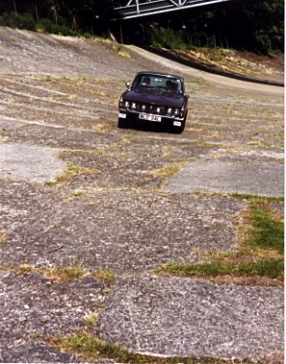
This is my favourite car.
Why? Because everything about it is just right for me - its looks, its handling, its performance, its relaxing nature, the way the doors close with a heavy, solid clunk. In spite of all the flirtations I've had with more exotic cars - Jensens, Alvis, Jaguar, Land Rover - I somehow keep coming back to this car time and again. The previous owner had the car for 21 years and for 17 of these, I looked after it for them. This is the fifth Rover P6 I've owned - I'm going to keep this one.
It's a lovely little car, with a wonderful roll on cornering (like the Citroen 2CV, except it leans in the opposite direction). Its design is pretty idiosyncratic but the quality of its construction is very good. Although it has 4 doors, it is really a 2 seater with room for the occasional two in the back. It's quite small inside but very comfortable and driving it, it doesn't feel like a big car at all.
Mechanically, it is quite complex - and certainly compared with Jensens. Suspension both front and rear is very unusual and rather complicated but manages to combine a nice ride with sports car handling. Nearly all of the front suspension is high up just under the windscreen so that the engine bay can be made very wide. Why? Well, Rover originally designed this car in the late 1950s to be powered by not a conventional petrol engine but a gas turbine. In other words, a jet engine. (Prototypes were made and still exist - I wish I had one. Apparently, the idle speed is 35,000 rpm ...) I think this was the first mass-production car to feature disc brakes all round (but I might be wrong here).
Body construction is unusual too. Clearly inspired by the 1955 Citroen DS, it features a sort of endo-skeleton or cage (Rover called this the 'base unit') onto which all the outer panels are fitted. This makes for an extremely strong and rigid frame and panels such as wings and doors can be changed in the event of accident damage or corrosion simply by undoing a few bolts. This also had exciting possibilities for body styling changes but sadly, this was never taken advantage of by Rover (chiefly for political reasons in the dark days following Rover's absorption into the British Leyland conglomerate in the mid-70s) although specialist coachbuilders in the UK brought out attractive estate-bodied versions, the Swiss coachbuilder Graber made some interesting bodies and Alvis made a 2-door prototype which never went into production (again due to politics, BL having sucked in even the tiny car-making side of this company whose main business was military tanks). With so much metal on board, it's a heavy car at 1.5 tons but it is precisely for this reason that it is so quiet and the ride so comfortable.
Powered by an all-aluminium 3.5 litre V8 engine (originally designed by Buick in the US in 1961, from whom Rover bought the entire rights in the mid-60s; a wise move indeed - the engine lives on in the Range Rover, some Land Rovers, various limited production cars such as the Morgan and TVR and fast police and ambulance vehicles). Performance from this 10.5:1 compression ratio engine is quite good and top speed is around 120 mph (although I did manage a sustained 140 mph+ in one of my earlier Rovers - Cambridge to Covent Garden in 29 minutes). Designed to run on 100 octane 5-star petrol (remember that?), it runs quite happily on 98 octane unleaded fuel without any detuning and does about 17 mpg around town (still cheaper than the London tube :-)
I use this car as an everyday car - it is 90% restored and just needs new wings (which simply bolt on) and minor repairs/repainting to the door panels. Strictly speaking, the cylinder heads also need overhaul as compression has dropped by about 25% compared with a new engine and the car lacks some of its former sparkle. But I'm wary of doing this - the heads have never been removed in a quarter of a million miles of motoring and I anticipate problems removing the head bolts; they are inclined to corrode into the block or head, or to shear off flush with the block.
Find out what's going on in the garage right now
Back to the car collection| main page
Andy Thomas, May 27th, 2010